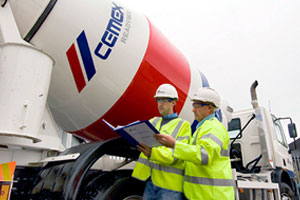CEMEX has a wide range of products and services, including technical support for its different types of ready-mix concrete. Below are a few examples of ready-mix concrete technologies with special properties and performance:
Standard Ready-Mix Concrete
Standard ready-mix concrete is the most common form of concrete. It is prepared for delivery at a concrete plant instead of mixed on the construction site, which guarantees the quality of the concrete.
Architectural and Decorative Concrete
This type of concrete can provide a structural function, as well as an aesthetic or decorative finish. It can offer smooth or rough surfaces or textures, as well as a variety or range of colors.
Rapid-setting Concrete
Designed to enhance early strength development, this concrete allows fast formwork removal, accelerated construction sequencing, and rapid repair for such jobs as roads and airport runways. Typically used in low temperature (5-10°C) concreting during winter, this concrete can also be used in buildings, railways, and precast applications. In addition to saving time, this concrete technology offers improved durability and acid resistance.
Fiber-reinforced Concrete
Concrete designed with micro or macro fibers can be used either for structural applications, where the fibers can potentially substitute for steel rebar reinforcement, or for reducing shrinkage—primarily early age shrinkage. Macro fibers can significantly increase the ductility of concrete, making it highly resistant to crack formation and propagation.
Fluid-fill Concrete
Fluid mortar or concrete simplifies the process of laying pipe and cable by surrounding the pipe or cable with a tightly packed shell that provides protection from the elements, prevents settling, and enables crews to work quickly.
Roller-compacted Concrete
Compacted in place and cured, roller-compacted concrete is a zero slump concrete with the abrasion resistance to withstand high velocity water—making it the material of choice for spillways and other infrastructure subject to high flow conditions. It represents a competitive solution in terms of cost and durability when compared to asphalt.
Self-consolidating Concrete (SCC)
SCC has very high flow; therefore, it is self-leveling, eliminating the need for vibration. Due to the superplasiticizers used—chemical admixtures that impart very high flow—SCC exhibits very high compaction as a result of its low air content. Consequently, SCC can have very high strengths, exceeding 50 MPa.
Pervious Concrete
Because of its unique design mix, pervious concrete is a highly porous material that allows water, particularly rainwater, to filter through, reduces flooding and heat concentration by up to 4°C, and helps to prevent skidding on wet roads. This concrete is ideally used in parking lots, footpaths, and swimming pool border applications.
Antibacterial Concrete
This concrete controls bacteria growth and is used to help maintain clean environments in structures such as hospitals, laboratories, and farms.
We take a customized and flexible approach to better serve our customers in every location where we operate.
For more detailed information about our ready-mix concrete products in your area visit the CEMEX website for your country.

